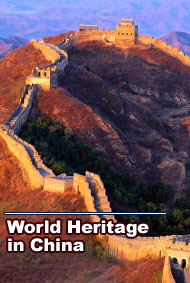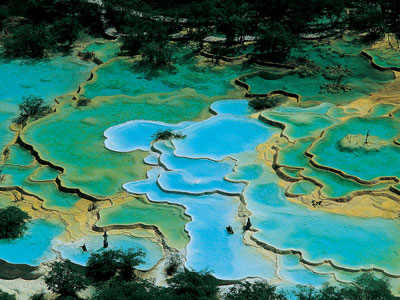
|
|
|
Huanglong Area of Scenic and Historic Interest (Sichuan Province)
Brief Introduction This mountainous landscape is famed for its colorful pools, snow-capped mountains, deep forests, waterfalls and diversified cultures. Covering about 700 sq. km in the northwest part of Sichuan province, the Huanglong valley is lined with snow-capped peaks which signify the easternmost of all China's glaciers. In addition to its mountain landscape, diverse forest ecosystems can be found, as well as spectacular limestone formations, waterfalls and hot springs. The area is also home to many endangered animals, including the giant panda and the Sichuan golden snub-nosed monkey. Physical Features Located in Songpan County, Sichuan Province, the Huanglong Area is a rare site of limestone landscapes. The 7.5-km Huanglong Valley is located at the foot of snow-capped mountains, near the source of the Fujiang River. At the end of the valley, near the foot of Green Jade Peak, water from melting snow mixes with limestone water from underground, flowing down the mountain terraces, depositing calcium carbonate from the limestone water on the rocks, stones and fallen branches in its path. The calcium carbonate, in turn, reacts chemically with organic and inorganic substances, resulting in various kinds of calcareous deposits that shine golden in the sunlight, just like a huge yellow dragon flying down from the snow-capped mountain, hence the name of the place. When the water flows into two separate streams, it turns into more colorful ponds and waterfalls. At the end of the gold-reflecting river is the Bathing Cave Waterfall, plunging 7 m down a cliff to turn into a water curtain. Nearby, the Brilliant Flying Waterfall, fed by the ponds on the upper reaches, cascades 10 m downward, with a width of 60 m. The jigsaw-like cliffs at the top of the waterfall split the water into small streams or curtains of water, creating a most fantastic sight. Of all the colorful pools, eight are most famous, i.e. the Flower-washing Pool, Bonsai Pool, Mirror Pool, Rhododendron Pool, Jade Plants Pool, Riot of Color Pool in the south, the Stone Pagoda Village Sea Pool and the Turning Flower Pool in the north. Flora and Fauna Huanglong is situated at the transition zone between the eastern damp forest zone and the mountainous coniferous woods/meadow grassland and shrub zone of Qing-Zang Plateau. It lies close to the intersection of four floral regions: Eastern Asia, Himalaya, and the subtropical and tropical zones of the northern hemisphere. Diversity of plants and animals here is high due to its location within four floral regions, its wide altitudinal range, and the extensive undisturbed forests. From 1,700m to 2,300m, there is a belt of mixed forest dominated by Chinese hemlock, Chinese or dragon spruce and three species of maple; between 2,300m and 3,600m, the forest is largely coniferous and subalpine in character; between 3,600m and 4,200m, the forest gives way to alpine meadows dominated by shrubs and grasses. Altogether there are 101 higher plant species of interest for their rarity, endemism, and ornamental and medicinal value, including some internationally threatened species. Some 16 species of rhododendron have been recorded from the site. As recorded in 1991, there are about 59 mammals (six orders and 18 families); 155 birds (12 orders and 29 families); five reptiles (two orders and three families); five amphibians (two orders and four families) and two fish species. A large number of the species listed are threatened at the national and international level, such as giant panda, golden snub-nosed monkey, brown bear, Asiatic black bear, Pallas' cat, Asiatic wild dog, Szechwan takin, Chinese monal and a number of waterfowl species. Historic and Cultural Value The unique scenery at Huanglong has been noted since ancient times. Tradition has it that the Zhenren (Perfect Man) of Huanglong, a Taoist immortal, meditated here. A pair of small stone pagodas is found in the Yuya or Jade-bathing ponds at the head of Huanglonggou. These are said to date from the Ming dynasty (1368-1644 AD) and to mark the burial place of Cheng Shichang, grandson of the founder of the Tang Dynasty, Cheng Yaoji. According to The Songpan County Chronicles, Huanglong's three temples, one behind the other, were built in the Ming Dynasty (1368-1644), and attracted a large number of worshipers. The front and middle temples are mostly dilapidated, but the back temple, at the end of Huanglong Ravine, and the Hall of the Goddess of Mercy in the middle temple are well preserved. The back temple contains a statue of the Perfect Man of Huanglong. In the middle of the sixth lunar month each year, a temple fair at Huanglong attracts local people from the Tibetan, Qiang, Hui, and Han ethnic groups. The fairgoers offer incense, pray, sing, dance, and enjoy the scenery. Much of the landscape of Huanglong, notably around Huanglonggou, is important in local Tibetan religion, culture and folklore. Legend has it that the Xishen Pubu, or Body Washing Waterfall here, is a place where the heavenly goddess Xuannu once bathed. It is believed to have healing properties for those who bathe in its waters, and can cure infertility. There are many other legends and stories associated with various natural physical features in the area. 
|